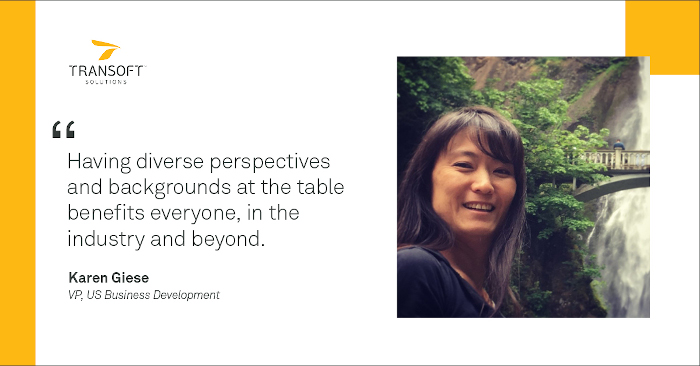Karen Giese, B.Sc & M.Sc. Civil Engineering, P.E., recently joined Transoft Solutions as Vice President of US Business Development based in Portland, OR. She shares her perspective on her career in transportation and diversity in the industry.
What inspired you to consider transportation planning as a career?
When I enrolled at Iowa State University, my focus was aerospace engineering. I quickly switched to civil engineering, because I wanted something more tangible and immediate in terms of community impact. In my senior year, I took a transportation course. I also became an undergraduate research assistant at the campus transportation research center. I really enjoyed it. That led to graduate school for transportation engineering.
My parents guided me toward engineering most of my life. They encouraged me to challenge myself with math and science courses. I grew up in Minnesota, and my parents had blue-collar occupations. They believed having a career in one of the major professions would provide me the most stability. Engineering made sense. And when I discovered transportation engineering, I knew it was where I belonged.
What are some of the highlights of your career to date?
When I was with PTV, a company that creates traffic modeling software, I helped lead the creation of a new program. I was able to take the idea from inception through to co-leading the development team to market launch. It was very satisfying to guide a major project all the way through.
Another highlight was representing Siemens Mobility at the Federal International Automobile Conference, held 2019 in South Africa. I was on the opening mobility plenary panel, which focused on the global mobility revolution and how technology will transform transportation.
Women are still underrepresented in your field and many industries, creating unique challenges. What challenges have you faced and what advice would you have for the next generation of engineers?
Having diverse perspectives and backgrounds at the table benefits everyone, in the industry and beyond. There is not yet enough diverse representation, but we’re seeing positive change. That is fantastic, because the more we see leadership by women and minorities, the more we’ll see that represented by younger people coming into the industry.
I had the benefit of parents and others in my life who encouraged me to go after what I wanted and not let others define who I am or what I am capable of. They helped me understand that, while I will face challenges as a woman and as a minority, only I can define who I am. They also taught me to be aware of other people’s challenges, understand not everyone has these resources, assist where I can, and be an example for others to follow.
My advice to young women and minorities is to be bold and do not be afraid to be good at what you do. Often, we are taught that we should concede to others around us or that we must always be kind-hearted and that being kind-hearted can’t happen at the same time as letting it be known we are good at something. This is untrue – you can do both.
My advice to everyone is to help others, look for opportunities to elevate others, especially those whose voices aren’t typically at the forefront.
You have been active in professional organizations. What are some of the benefits?
Professional organizations allow you to be part of the community and build relationships. It’s about understanding and learning from other people. If you have an idea, and others want to move the same concept forward, you can reach out for support. If you’re working through a project, sometimes just being involved in the discussion you’ll hear something you might not have thought about, and that will help you achieve clarity.
What role does innovation play in the design of safe and sustainable infrastructure? And in your opinion, what is the future of transportation?
Innovation allows us to recognize the improvements needed to better accommodate people, and to improve how we design more efficient infrastructure. Cities are trying to find ways to keep everyone safe and provide access to services. Transportation plays such a key role in ensuring people have equitable access.
I think in the future there’s going to be a lot of connected infrastructure. What’s fascinating and motivating is seeing crossover in leveraging technologies to create large-scale solutions. For example, electric vehicles can improve transportation and address climate change. That technology ties in with electricity providers working to optimize grid systems, and with transportation planners and engineers looking to build safe and efficient infrastructure. These solutions create new connections and discussions among industries.
One reason I joined Transoft is because it is innovative. I like being part of the bigger discussion shaping the future of transportation, and I hope to help Transoft be a leader in that discussion as well.
